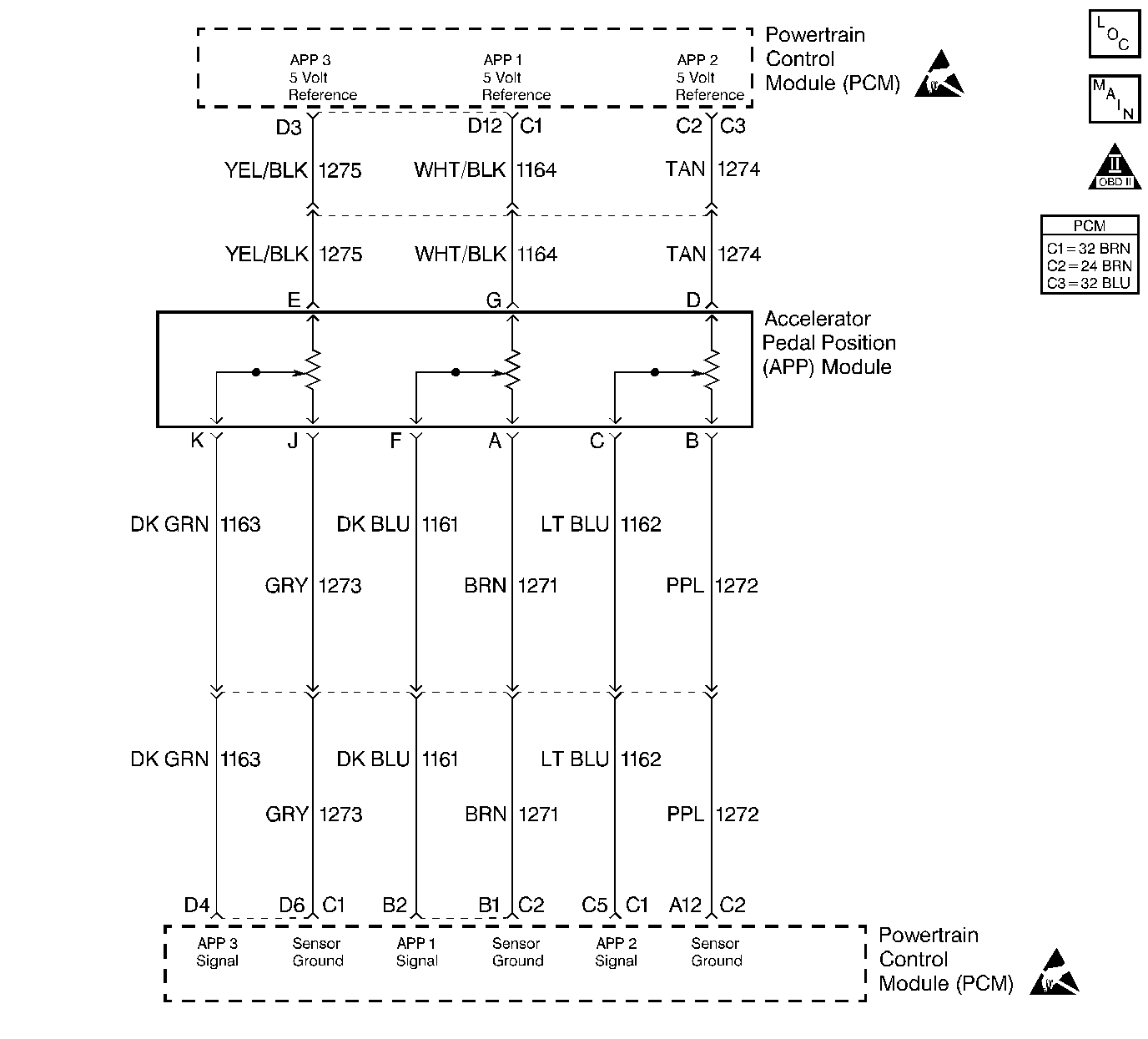
Circuit Description
The accelerator pedal position (APP) module provides a voltage signal that changes relative to accelerator position. There are three sensors located within the APP module that are scaled differently.
Conditions for Running the DTC
| • | The PCM performs this DTC diagnostic continuously. |
| • | The ignition voltage is more than 6.4 volts. |
| • | Engine speed is more than 300 RPM. |
| • | No in range faults for APP 1 or APP 3 (PCM checks for high and low voltage faults). |
Conditions for Setting the DTC
| • | The difference between APP 2 and APP 1 is more than 0.23 volts (PCM compares pre-scaled voltage (internal to PCM)). |
| • | The difference between APP 2 and APP 3 is more than 0.50 volts (PCM compares pre-scaled voltage (internal to PCM)). |
| • | All of the diagnostic set conditions met for 2 seconds. |
Action Taken When the DTC Sets
| • | The input from APP 2 sensor is ignored. |
| • | This DTC will not turn on the Service Throttle Soon lamp by itself. |
| • | The throttle will operate normally as long as there is only one malfunction present. If there are two APP malfunctions present, the PCM will then turn ON the Service Throttle Soon lamp and limit power. If a third APP malfunction is present, the Service Throttle Soon lamp will be ON and will only allow the engine to operate at idle. |
Conditions for Clearing the MIL/DTC
| • | A History DTC clears after forty consecutive warm-up cycles, if this or any other emission related diagnostic does not report any failures |
| • | The use of a scan tool. |
Diagnostic Aids
There are no driveability issues associated with the APP module unless a DTC is present. The most likely causes of this DTC are poor connections or the sensor itself. The least likely is a PCM problem.
An intermittent may be caused by the following:
| • | Poor connections |
| • | Rubbed through wire insulation |
| • | Broken wire inside the insulation |
A scan tool reads APP 2 position in volts and should read about 4.5 volts with the throttle closed and the ignition ON or at idle. Voltage should decrease at a steady rate as the throttle is moved toward WOT. Also, 90% pedal travel is acceptable for correct APP operation. Scan APP 2 sensor while depressing the accelerator pedal with the engine off and the ignition ON. Display should vary from about 4.5 volts when the throttle is closed to about 1.5 volts when the throttle is held at wide open throttle (WOT).
Test Description
Number(s) below refer to the step number(s) on the Diagnostic Table.
-
This step determines if there is a good 5 volt reference.
-
This step will check for an open in the ground circuit.
Step | Action | Value(s) | Yes | No |
|---|---|---|---|---|
1 |
Important: Before clearing the DTCs, use the scan tool Capture Info to save the Freeze Frame and failure records for reference. The control module's data is deleted once the Clear Info function is used. Did you perform the Powertrain On-Board Diagnostic (OBD) System Check? | -- | ||
2 |
Are the APP voltages at the specified values (values are listed as APP 1, APP 2, and APP 3 respectively)? | 0.45-0.95 V 4.0-4.5 V 3.6-4.0 V | ||
3 | The DTC is intermittent. If no additional DTCs are stored, refer to Diagnostic Aids. If additional DTCs were stored, refer to the applicable DTC table(s) first. Are any additional DTCs stored? | -- | Go to the Applicable DTC Table | Go to Diagnostic Aids |
Is voltage greater than or equal to the specified value on all circuits? | 4.75 V | |||
Is the test light ON (all circuits)? | -- | |||
6 |
Was the 5 volt reference circuit open or shorted to ground? | -- | ||
7 | Check the 5 volt reference circuit for a proper connection at the PCM and replace terminal if necessary. Did the terminal require replacement? | -- | ||
8 |
Was APP sensor ground circuit open? | -- | ||
9 | Replace the APP module. Refer to Accelerator Pedal Position Module Replacement . Is the action complete? | -- | -- | |
10 | Replace the PCM. Important: The new PCM must be programmed. Refer to Powertrain Control Module Replacement/Programming . Is the action complete? | -- | -- | |
11 |
Does the scan tool indicate the diagnostic Passed? | -- | ||
12 | Does the scan tool display any additional undiagnosed DTCs? | -- | Go to the Applicable DTC Table | System OK |
